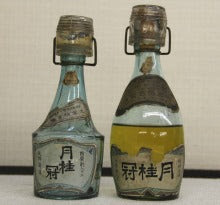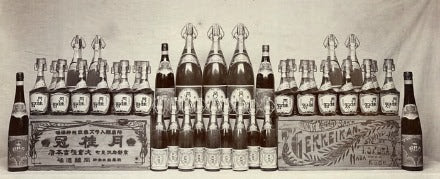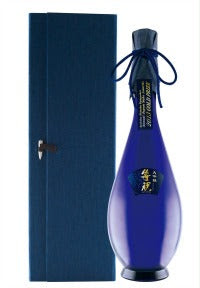Sake Bottles – The Color Game!
Raise your hand if you take sake bottles for granted! (That’s the sound of me lifting my hand above my head.) Sure they are pretty and come in amazing shapes, but sake bottles in “olden times” did not exist and the evolution of the sake bottle is quite a story in color and look. But where do we start? Sake as we know it has been around for about 1,000 years but what the heck was it contained in?
Similar to other ancient boozy beverages, sake was stored in jugs, wooden casks, and even in dried gourds. Yup! That’s one hell of a pumpkin! Now you know why jack-o’-lanterns are all smiling! (Not true, I just made that up.) In any case, the sake vessel changed with the times. From clay and ceramics, to cedar casks, to rope and rice stalk covered pots. If it didn’t leak it held sake. I personally find the old ceramic sake pots that adorn True Sake to be my favorite vessels. These off-white pots were the “milk bottles” of the past, where villagers would bring the pots down to the brewery to be filled and refilled. For me it is the iconic image of sake, but I’m old school like that!

Fast forward to 1878 and that pioneering brewery in Fushimi Kyoto called Gekkeikan. Yes, say what you want, but this brewery was single handedly responsible for many “firsts” in the sake industry and they are awesome! It was the Gekkeikan brewery that first put sake into bottles! God bless you good people! They and they alone get credit for taking sake to that next step! But with glass comes a new set of concerns for the preservation of a product that is light and heat sensitive. So they also get credit for starting the bottle war.

Sake brewers eventually found out the hard way that sake was actually sort of fragile and that the wonderful thing called the sun could really wreak havoc on this perishable product. So glass changed colors to keep the pesky sun at bay. The first wave of bottles came in the standard brown bottle. Then green came into play. And for a long while a really cool light blue bottle was very prevalent. But obviously for more protection from UV light, the sake needed the darker the bottle.
Over the years we sort of waited for new colors to pop up! I remember seeing my first red bottle and I was like wow! Then a few months ago I saw a purple bottle that would make Prince proud. So the game became marketing and since then sake bottles and bottle packaging has taken on an indentity all of its own. Sake bottle packaging is a business unto itself. I know breweries that source their bottles in Italy. I know breweries that commission artists to design their bottles. It’s almost gotten insane, but then again who’s to say.
Today when you see bottles you should ask yourself some questions. Hmmm what sort of sake is in clear glass bottles? Well, for one it probably is filled with a fresh sake like nama that should be consumed quickly and as such doesn’t need dark glass. Or maybe it is a “Kinpaku,” which means gold foil sake that has flecks of gold floating in the brew. Or maybe it is Usu-Nigori, which means a misty sake so you can see the unfiltered rice particles. What about bottles with those “socks” around them? That’s just another way to protect the sake from UV. These cotton-like socks cover the bottle and are twist tied at the top. There are also new “UV” clear bags that actually filter the suns rays better than an actual solid sock. Cool!

Then of course, there are the boxes! You don’t really see the amazing light blue-pounded glass bottle inside the box, but the box looks cool and it protects the sake. Some breweries today try to brand their identity by using a specific bottle. For example the Shirataki brewery in Niigata has a series of beveled bottles in various colors that are very distinguishable. And then there are breweries who don’t give a rat’s ass about their bottle, they just want to spend their money on making great sake and they put it in bottles of all sizes with the same neck size to save money on bottling equipment.
I’ll never forget the day that I saw the Wakatake bottle. Cool! It’s square! And it created an identity for their Junmai Daiginjo. The bottle was so popular that they incurred the extra expense and started putting their Junmai and Junmai Ginjo in the square bottles. It worked for me! Then other brewers looking to re-brand would try an entire new line of white bottles with labels that were different colors. Basically bottles have become the same extension of the brewery as the labels themselves.

There are some stellar bottles out there. Pear-shaped, grenade-shaped, gourd-shaped, tobin-shaped, etc. They are distinctive and are a large part of a sake brewery’s expression. Some bottles come in woven baskets, dried leaves, rice stalks, newspaper, and other materials, but these styles all do the same thing and that is protect the sake from UV in a cool and marketable way.
Is this a bit much though? I always say no, because a used bottle is not over! It’s old life as a container for sake is over, but its new life as a vase has begun. Many of these stylized bottles are great for collecting. But, for you green folks I have a funny story for you.
On my first trip to Japan to visit some breweries, I thought I was well prepared to see the equipment that I had studied for so long. I was ready to name machine after machine that is used in making sake. And yes, I was a little cocky. One owner of a brewery was impressed that I knew the name and function for each device. Yes, I was on a roll, and then we turned the corner. “What the hell is that?” The owner laughed like I was joking. But I wasn’t joking. “What in God’s name is that thing?” So I did the cowardly thing and laughed like I knew and went on with the tour. Yes I was a little ashamed, but it didn’t last long, because I saw the damn thing again at another brewery. “What the hell is that?” Owner laughing again! No seriously what is that? “It’s our bottle washing machine.” Say what?
The Japanese sake business does a great job recycling bottles in Japan. Most breweries have bottle washing and sanitizing machines that clean bottles that are returned from bars, restaurants, and retail centers. It’s a pretty cool system, and it sort of makes me wonder how often and where do certain 1.8L bottles go during their journeys. It’s very cost effective and green as green can be.
So the next time you see a sake bottle now you know!



